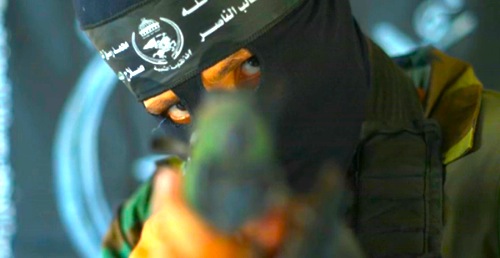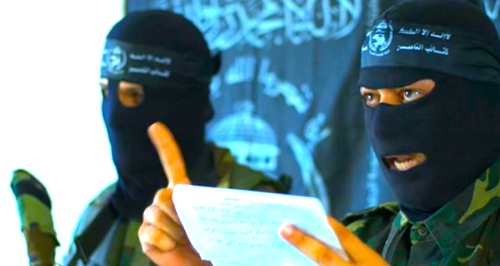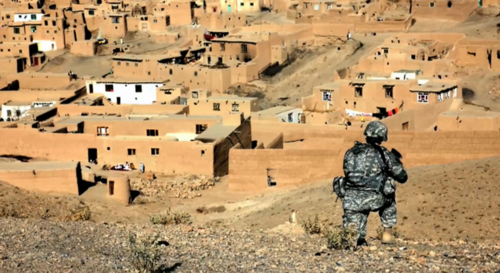[Editor’s Note: Recently I came across this striking video above, by New York-based filmmaker Richard Mosse. At first glance, I was shocked by what appeared to be a shahid-style terror video made by a Western filmmaker. Watching the video through, however, it occurred to me that this likely was not an actual terror video, so much as a kind of ‘genre’ piece or riff on terror videos. My thoughts then moved to the question of what an expert in this area might think of it. Fortunately I was able to turn to LFM Contributer ‘Max Garuda,’ who works in the field and has access to Arabic translation.]
“A short terror video made in Gaza. Possibly the only such video ever made by non-Palestinian producers. As a result, the representation breaks with the conventions of the Palestinian suicide video genre. In Arabic, ‘shahid’ means martyr, or witness.” – Filmmaker/photographer Richard Mosse, describing his video Shahid.
By ‘Max Garuda‘. The artist’s commentary above alerts the viewer to the existence of a ‘terrorist video genre,’ and that Mosse’s creation breaks with that category. This assertion raises two questions: what is the ‘terrorist video genre’ and what conventions does Mosse’s video contest? (An argument can be made that any film belongs in any genre if anyone can make a compelling argument for inclusion. Or, said differently, film/video genres are not fixed sets of criteria by which categorizations are easily made. Rather, they are fluid, evolving bodies of work, responding to artistic practice, distribution/marketing strategies and audience expectations.)
That being said, why does Mosse desire to characterize his video within the ‘terrorist video genre’ or by comparison to it – especially when the differences that do exist are so significant enough to make a strong argument that his video doesn’t break from the genre, but rather has nothing to do with the genre. But first, a little background on the ‘terrorist video genre.’

As the title might suggest, the most obvious distinguishing characteristic of the genre was originally the provenence of the video followed by content. Generally speaking, only terrorists made ‘terrorist videos,’ which were used to showcase the terrorizing act or transmit a message requiring some expression of authenticity. The terrorist act depends on shock and a visceral reaction by the ‘public’ of the terrorized. A beheading that occurs in the forest is just a beheading; a beheading captured on video and spread globally by broadcast news or the Internet is an act of terror. Videos showing murders, explosions and other deadly acts were created to broaden the impact of the terrorist act. The ‘theater of terror’ is a common framework for understanding terrorism, in which the terrorist’s act must have the paralyzing effect of fear – because the scope of the actual violence is quite limited. Even the 9/11 attacks, with their relatively high death toll, depend on the ‘theater of terror’ effect for their power–changing how Americans (and other countries and their citizens) conduct their daily lives, from intrusive security measures to a simple constant state of fear. Many early terrorist videos operated in this domain.
The other common example of early terrorist videos were simply video-based messages. Whether VHS tapes smuggled out of remote bivouacs to eager news outlets or digital videos posted to websites, the form of the terrorist video was targeted primarily at followers of the movement, to ensure them that the leadership was still alive and in control. Hence, the periodic release of a video of Osama bin Laden exhorting his followers or Ayman al-Zawahiri expounding on a facet of Islamic exegesis that fits his extremist goals. The target of these videos was generally the faithful, and secondly the ‘contested populations’ or those that don’t openly support the extremists but aren’t too convinced of the piety, competence and forthrightness of local government.

More recently, though, we see a fusion of these two goals (theater of terror and strategic messaging) into the genre of the ‘terrorist video’ that Mosse and his collaborators purport to produce. In this newer class of terrorist videos, we usually see direct address of the camera by the producing group, images of their heroes (Bin Laden, Al-Zarqawi, etc.), and sometimes images of their terrorist acts or types of acts the video implies are imminent. Because these newer videos are not as gruesome as the beheading type video, and because they are frequently hagiographic in their treatment of extremist heroes and martyrs, their access to the ‘theater of terror’ is less about instilling fear in a subject population, but rather in making a spectacle of the process of terrorism and thus improve recruitment within the contested population (particularly disaffected youth). Continue reading EXCLUSIVE: Libertas Reviews a ‘Terror Video’

